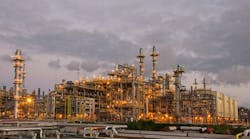By the OGJ Editors
WASHINGTON, DC, May 3 --The US Court of Appeals for the D.C. Circuit on Friday upheld a controversial low sulfur diesel fuel issued by the Environmental Protection Agency and opposed by industry.
Refiners that filed suit against the agency called the court's decision "disappointing."
"The decision seems based on the panel's reluctance to substitute its judgment for EPA's questionable determination about the impact of this regulation on supplies of highway diesel, the nation's premier commercial fuel," said Bob Slaughter, president of the National Petrochemical and Refiners Association. "This case has never been about whether the sulfur content of highway diesel fuel will be substantially reduced; it will be. NPRA has consistently supported environmental improvements such as lower-sulfur fuels.
"This case was about whether sulfur reductions should occur in a reasonable timeframe, to maintain needed fuel supplies and ease the impact on the already stressed U.S. refining system."
NPRA officials said they are studying the decision and have not yet made a decision on whether they will appeal the rule.
In an earlier written statement, NPRA said that if EPA in the end is the final court of opinion on the impact the rules have on fuel supply, Congress and President George W. Bush's administration "must insist that EPA pay more attention to the timing and sequencing of future rules than it did in this case."
NPRA also lauded the court for holding that EPA is legally required to assure an adequate fuel supply in rules of this kind. "We hope EPA will pay close attention to supply implications as implementation of this rule progresses," it said.
Environmentalists cheer
Environmental groups meanwhile lauded the court action. Frank O'Donnell, Executive Director of Clean Air Trust, said it was a "huge victory" for clean air. He said EPA's diesel rule would prevent 8,300 premature deaths each year and prevent 5,500 cases of chronic bronchitis and 17,600 cases of acute bronchitis in children each year. In addition, he claimed, it would prevent more than 360,000 asthma attacks and more than 386,000 cases of respiratory symptoms in asthmatic children per year.
Under EPA's rule, new trucks and buses would be up to 95% cleaner than today's models, O'Donnell said. Trucks today produce more pollution overall than they did in 1970, when the Clean Air Act was passed, he said. That's because few trucks use pollution controls.
To enable use of high-technology pollution devices, EPA's rule requires refiners to remove 97% of the sulfur from diesel fuel. Small refiners may ask for more time to comply with the rule, which starts in 2007.
"It means that future trucks and buses would be as clean as those that run today on natural gas. EPA projects the rule ultimately will cost about $4 billion dollars per year and bring more than $70 billion a year in benefits," O'Donnell said.
EPA relooking
Despite the praise from the environmental community, there is still enough concern by refiners over the cost of the rule that EPA wants a stakeholder panel to take a second look and issue recommendations by mid-September 2002. Meetings start later this month and will be open to the public (OGJ Online, Apr. 24, 2002).
In a letter to refiners, automakers, clean air groups and state officials, EPA said the panel will review the progress of: manufacturers of diesel engines and emission control systems in developing technology to reduce engine exhaust pollutants, and the fuels industry in developing and demonstrating technologies to effectively lower the sulfur level of diesel fuel.
Technical review
EPA said it is also conducting a technical review, "as part of our ongoing assessment of progress that industry is making toward the program's implementation. The first of these agency reports will be provided to the panel in order to bring all the participants up to date with EPA's understanding of the situation and to provide a starting point from which to conduct its review."
Last June EPA signaled it would pursue an independent study to take a second look at the Clinton administration era rule. The rule now on the books would force refiners to meet a 15 ppm standard before 2007 on 80% of diesel supply. The remaining 20% would be phased in by 2010 (OGJ Online, June 6, 2001).
NPRA cautions
NPRA said it continues to believe the rule will have adverse consequences on fuel supplies, and could mean more refinery shutdowns at a time when the industry has little if any spare capacity to meet growing demand for transportation fuels
"EPA unwisely chose to ignore the advice of the National Petroleum Council and others and required the industry to comply with this rule in the same time period as the equally challenging and expensive gasoline sulfur reduction regulation," NPRA officials said.
"One refinery in the supply-short Midwest was closed last year for the stated reason that it could not justify contemporaneous investments in both these rules; another Midwestern refinery has announced that it will close this August, once again citing as a reason the cost of the simultaneous reductions of sulfur in both gasoline and diesel fuel.
"It is ironic that this decision occurs during the same week in which a Senate Committee report criticized the refining and gasoline marketing industry because of increased concentration in certain key markets, including the Midwest. This rule is already reducing U.S. refinery capacity and fuel supply production, four years before its implementation date. This is why NPRA believes that EPA failed in its duty to sequence this rule in a more reasonable time frame."

